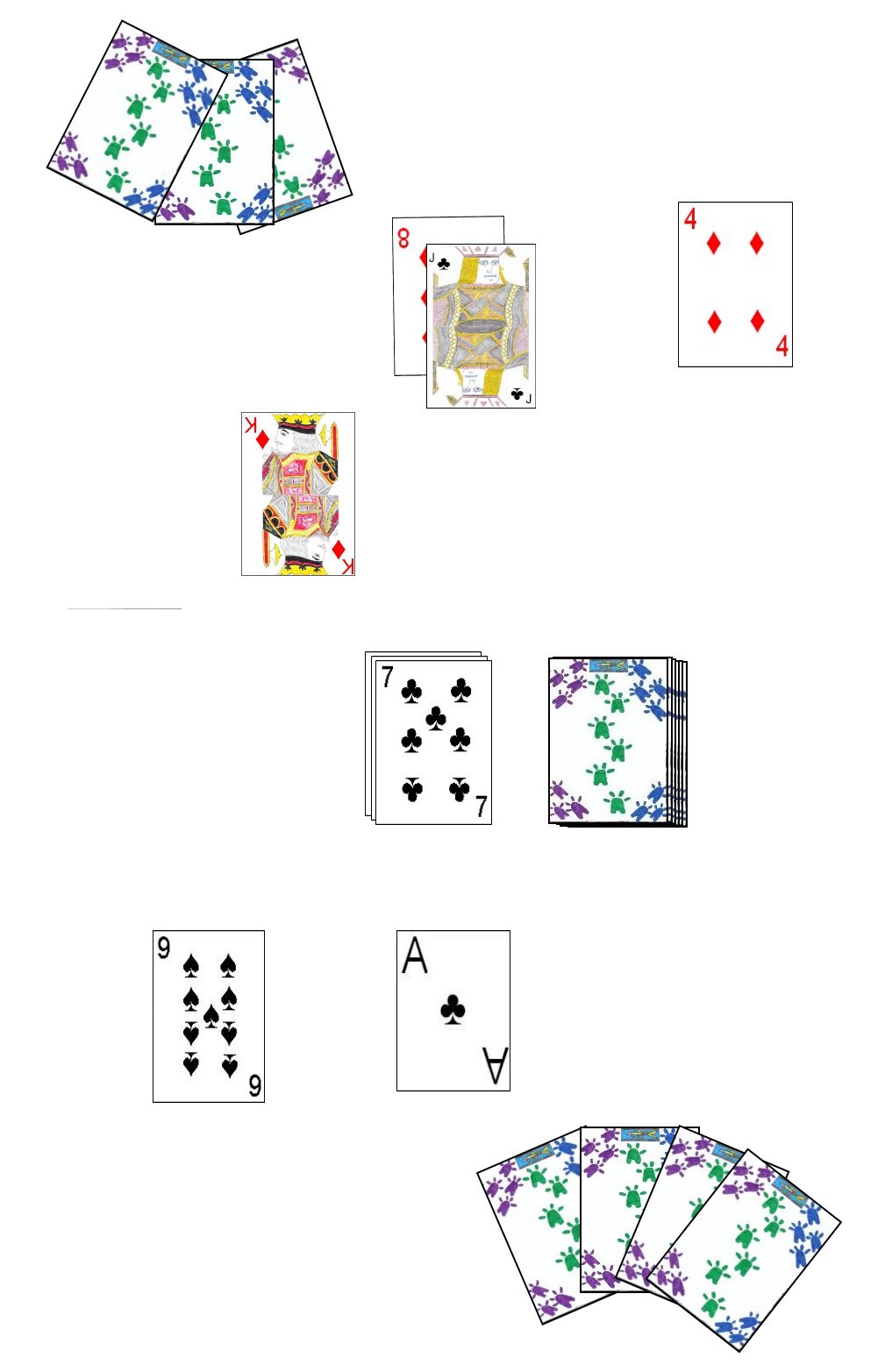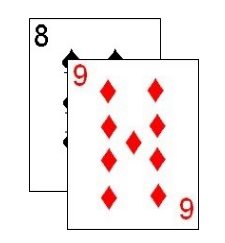 Determination of the first dealer can be performed using a number of methods, with cutting for low card common. If both players cut a card of the same rank, they should each draw another card. The player cutting the lowest card then becomes the first dealer, and the deal alternates between the two players each hand thereafter.
Determination of the first dealer can be performed using a number of methods, with cutting for low card common. If both players cut a card of the same rank, they should each draw another card. The player cutting the lowest card then becomes the first dealer, and the deal alternates between the two players each hand thereafter.
To begin the dealer should thoroughly shuffle the cards and offer the deck to his opponent to cut. After the cut, he then begins dealing the cards to each player. The dealer's opponent should receive five face down cards and the dealer receives six. The dealer then places the remainder of the deck face down in the center of the table as the draw pile. The dealer's opponent has the first turn.
On each turn a player may elect to perform one of five actions:
- Draw: The simplest action a player can make on his turn is to simply draw one card from the top of the stock pile, adding it to his own hand.
- Play a Point Scoring Card: A player may play any numbered card (Ace, 2, 3, 4, 5, 6, 7, 8, 9 or 10) from his hand, face up in front of himself on the table (each player's layout is called a Cuttle). The total sum of point cards in front of a player is his current point total for the hand. He should keep his own card layout distinct from his opponent to avoid any confusion.
- Play a One-Off Card: A player may play a special "one-off" card into the discard pile. Doing so allows the player to utilize the one use special feature of the card (detailed below).
- Play a Layout Card: A player may play a special designated "Layout" card on the layout in front of himself. The special effect of this card then begins immediately.
- Scuttle: A player may play a special card which has the capability to "Scuttle" or nullify one of his opponent's point scoring cards. He does this by playing the scuttle card on top of the opponent's point scoring card. Both cards are then removed from the layout and moved to the discard pile.
As can be seen, much of the game revolves around the play of special cards (either as an immediate one time impact on the game, to scuttle an opponent's point scoring card, or to play a layout card to the table on his own layout). As such, certain cards can have specific effects depending on how and where it is played. The following are the allowable cards that can be played to the discard pile as a one-off on a player's turn and the effect they will have on the game:
| Card | Special Effect |
|---|---|
| Jack | A player plays it on top of any one of an opponent's point scoring cards in that opponent's layout. The point scoring card is left on the layout, however the point value for that card is counted for the player who played the Jack instead. If a second Jack is played on the first Jack, the ownership of the point total is then transfers to the original player. Up to four Jacks can be played on any point scoring card. If the point scoring card is removed from the layout for any reason, the Jacks are also discarded. |
| Nine | Allows the player to select any card from his opponent's layout and force the player to add it back to his own hand. The nine may also be played to force an eight by a player back into that player's hand. |
| Seven | Allows the player playing the seven to immediately draw a card and play it as applicable. If the card drawn cannot be legally played for any reason, the player must discard it to the top of the discard pile. |
| Six | Forces both players to immediately remove all non-point cards from the layout and add them to the discard pile. Any effects of these cards is removed. |
| Five | Entitles the player to immediately draw two cards from the top of the draw pile into his own hand. |
| Four | Forces the opponent of the player who plays the four to discard any two cards of that player's choosing to the discard pile. |
| Three | Allows the player to look through the discard pile and take any one card of his choosing into his own hand. |
| Two | Playing a two entitles the player to play any one card (which is not a point card) from either player's layout into the discard pile, ending any effects that card might have. |
| Ace | Playing this card to the discard pile instantly forces both players to discard all point cards in their current layout. |
In addition to playing cards to the discard pile as a one-time effect, a player can play cards to his own layout. The following shows the effects of these cards:
| Card | Effect |
|---|---|
| Ace, 2, 3, 4, 5, 6, 7, 8, 9, 10 | Increases the number of points in the layout for that player by the number indicated on the face of the card. An Ace counts as one point when used as a point card on a player's layout. |
| King | Adding a King to a player's layout allows that player to reduce the number of points required for that player to win. As the normal point total required for the win is 21, one King reduces the necessary total to 14 or more, two Kings reduces it to 10 points or more, three Kings reduces it to 7 or more and having all four Kings in a player's layout reduces the points required to 5. |
| Queen | When a player adds any Queen to his layout, none of that player's other cards in his layout may be effected by a Jack or Two played by his opponent. |
| Eight | In addition to playing an eight as a point scoring card it can also be played to have an ongoing effect on the game. When played in this way, the eight is not actually played to either player's layout. Instead, it is played to the center of the table between each of the players' layouts. When an eight is thus played, the opponent of the player who played the eight must play with his hand fully exposed on the table. If, for any reason the eight is removed, that player can again pick up his hand no longer required to expose the hand to his opponent. That player can also play an eight of his own to the table, forcing his opponent to also play with his hand exposed on the table. |
 A player may also, on his turn, use a point scoring card to Scuttle one of his his opponent's point scoring cards. To do this, on his turn the player places a card of a higher point value on a point scoring card of his opponent. Doing so forces the opponent to discard that card (as well as the card used to Scuttle the card) to the discard pile. A player can also Scuttle the card with a card of equal value, if the Scuttle card has a higher ranked suit. The ranking of the suits for this purpose are as follows (from high to low); Clubs, Diamonds, Hearts, Spades.
A player may also, on his turn, use a point scoring card to Scuttle one of his his opponent's point scoring cards. To do this, on his turn the player places a card of a higher point value on a point scoring card of his opponent. Doing so forces the opponent to discard that card (as well as the card used to Scuttle the card) to the discard pile. A player can also Scuttle the card with a card of equal value, if the Scuttle card has a higher ranked suit. The ranking of the suits for this purpose are as follows (from high to low); Clubs, Diamonds, Hearts, Spades.
There is also one option which allows a player to play during his opponent's turn, called a Counter. If a player's opponent plays a one-off on his turn, a player with a two may play that two directly on top of that card to nullify it's effect. Multiple twos can actually be played in this way, with each two nullifying the previous two.
As noted, the first player to reach or exceed 21 points at any time in the game is declared the winner. If a player possesses one or more Kings the actual total required for that player may be reduced as described above. If the stock pile runs out during the game, a player may elect to Pass on his turn. If there are three successive passes, however, the game ends in a tie.